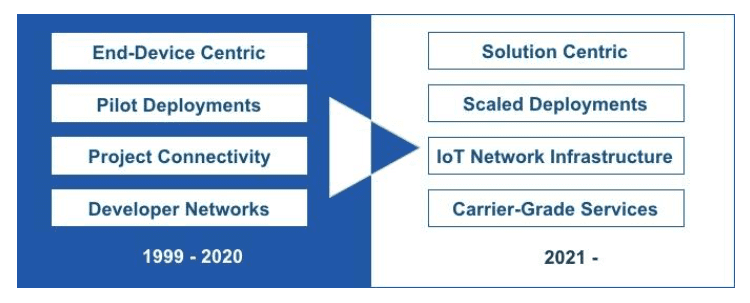As IoT deployments continue to scale and solution requirements become more predictable, the market will recognize the clear distinction between carrier-grade low-power wide-area (LPWA) networks and those that fail to meet carrier-grade specifications. This distinction will draw clear lines between commercial and consumer grade networks, with commercial applications for critical infrastructure and essential business needs trending toward utilizing carrier-grade networks throughout their evolution from development to massively-scaled deployments.

As the market has matured over the past few years, several innovative LPWA network architectures and ecosystem engagement models have emerged to connect what is estimated to be over half the world’s IoT devices. These include decentralized hotspot networks, crowd-sourced developer networks, shared community networks, and cloud-managed, carrier-grade, SLA-backed networks.
While these various connectivity options have evolved, a clear distinction between their capabilities has not been effectively marketed or reported. Combined with a land grab by network operators, this has impacted IoT solution sales cycles as end-customers are forced to sift through feature comparisons, trial different connectivity options, and in some cases, convert from one network provider to another after experiencing performance or support issues.
Carrier-grade performance will be made possible by the robustness of cloud-based connectivity architectures and the rigorous analysis applied to configurations of gateways end devices from the point of initial instantiation through all phases of network expansion. Being able to securely connect, activate, monitor, and manage IoT devices at massive scale in a multi-tenant and multi-vendor environment – across a broad range of applications, and under solution-based SLAs – will become the standard for carrier-grade network operators.
Operators providing carrier-grade service will need to be able to manage the OSS/BSS features of their network server, packet core, data streaming, security, and performance of the radio-access network (RAN). In addition, the IoT application management environment provided by the network operator must efficiently enable IoT gateway deployment and provide scalable, secure, end-device onboarding, application service provisioning and visualization tools.
Anything short of this will define the network as developer- or consumer-grade. Developer and consumer networks will serve an important purpose in the proliferation of connected devices and contactless data collection, but carrier-grade networks will emerge as the IoT connectivity platform of choice for critical infrastructure and essential business needs.

LPWA network technology has paved the way for pervasive use of IoT across markets. A major force behind the next wave of growth will be predictable performance and cost-effective availability, which will come with carrier-grade networks. Carrier-grade LPWA services offer the opportunity to disrupt existing business models and entire industries, especially those that have not traditionally been technically oriented.
Business operations and activities will become IoT-enabled without people realizing that the technology is in operation – as an everyday part of our everyday lives. As a result, the world will be powered by IoT data. Over time, the whole concept of IoT will merge with cloud and edge computing and we will just think of these projects as applications versus IoT.
For IoT applications to live ‘in the background’ as part of ‘everyday life’, the wireless infrastructure that connects remote devices must be professionally designed, deployed and managed to meet fit-for-purpose SLAs. With this, solution providers and end customers will have peace-of-mind that their IoT network operates as intended – and if something does go wrong, that it will be resolved based on carrier-grade SLA metrics, potentially, many times without them even knowing there was a problem.

